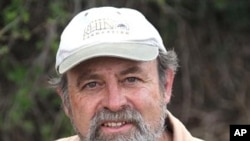Zimbabwe has one of the largest populations of black rhinos in the world.But conservationists say their numbers are declining, mostly because of man-made problems, including poaching and human encroachment, as people look for new land to farm. Every year hundreds of rhinos are killed for their horns, which are sold for medicinal purposes in markets as far away as Asia.
The Goldman Environmental Prize recently went to Raoul du Toit, coordinator of the African Rhino Program at the Florida-based International Rhino Foundation and one of a small number of conservationists working to preserve the animals. The Goldman Environmental Prize is awarded to those working at the grassroots level to protect and enhance the environment.
Rhinos are victims to poachers who are more active because of the decline in law enforcement in the conservation areas, said du Toit. He attributes the situation in Zimbabwe to a lack of resources and political and economic turmoil.
Animal-human competition
Black rhinos are also threatened by competition from the relocation of people into conservation areas in search of land for growing food crops. “There has been a kind of haphazard and disorganized settlement going on,” he explained, “where there is potential for major livestock problems with disease transmission from wildlife to livestock….”
Human settlements are driven by economics and by politics. Du Toit said the Zimbabwean government’s fast track land resettlement program has led to an expansion of subsistence farming in the rhinos’ wild habitat.
He said the program “was not adopted in a way that incorporates wildlife land reform adequately.”
Du Toit dismissed the claim by some that a decline in wildlife is natural as animals compete with humans for land and that the animals will adapt and survive.
“A lot of wildlife has been lost in Zimbabwe in areas that are settled,” he said, pointing to the reduction of “big animals like elephants and rhinos.”
“Big game cannot live around farms and gardens, because they will ultimately overrun it” and be killed by the community, which can also sell their horns.
The way forward
Du Toit mentioned some of the practical efforts. Rhinos have been moved to areas in southern Zimbabwe where cattle ranches have been converted into wildlife conservancies that protect and breed animals.
Help has also come from the private sector, which du Toit said is seeking government partnerships and engagement with local communities. The ultimate goal, he said, is to sensitize people about the need to preserve the rhino population.
Economic incentives can provide income and local employment, like tourist lodges owned by the community. Du Toit said he is far from advocating that every square kilometer in Zimbabwe be given to wildlife. “There should be crop production…livestock production…mining…but what we want,” he said, is a better “approach towards fitting together these uses within the landscape.”
What’s needed, he said, is a greater efficiency in resource use and more technical support, combined with what he called more rational government policies.








